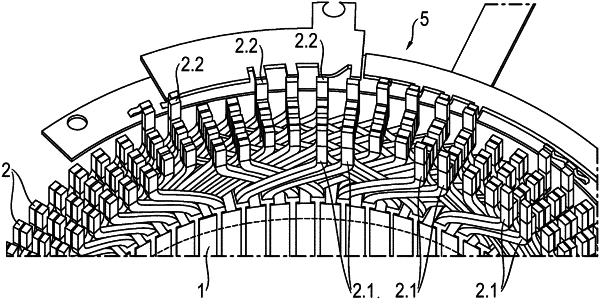| CPC H02K 15/064 (2013.01) [H02K 3/04 (2013.01)] | 10 Claims |

|
1. A coil comprising:
a coil body;
a distributed winding formed from a plurality of hairpins, wherein each hairpin comprises:
two straight-line conductor portions arranged in respective slots of the coil body;
contact regions shaped in circumferential direction adjoin the conductor portions at one axial end;
a turning region at an other axial end by which the conductor portions are connected; and
a respective connection portion at an end of each contact region, wherein the connection portions are aligned in radially extending rows,
wherein an even-number quantity of conductor portions is provided in each instance in the slots of the coil body in layers in radial direction,
wherein the contact regions of a layer are shaped in a same circumferential direction,
wherein a portion of the contact regions of an outer layer, the outer layer being at least one of an a radially inner layer and a radially outer layer, is deformed in radial direction to form an additional layer,
wherein the contact regions are arranged in more layers than conductor sections in the slots, and these contact regions are shaped in a circumferential direction opposite the contact regions of the outer layer,
wherein the contact regions of the additional layer are arranged in a same row with contact areas of the outer layer for direct connection thereto.
|